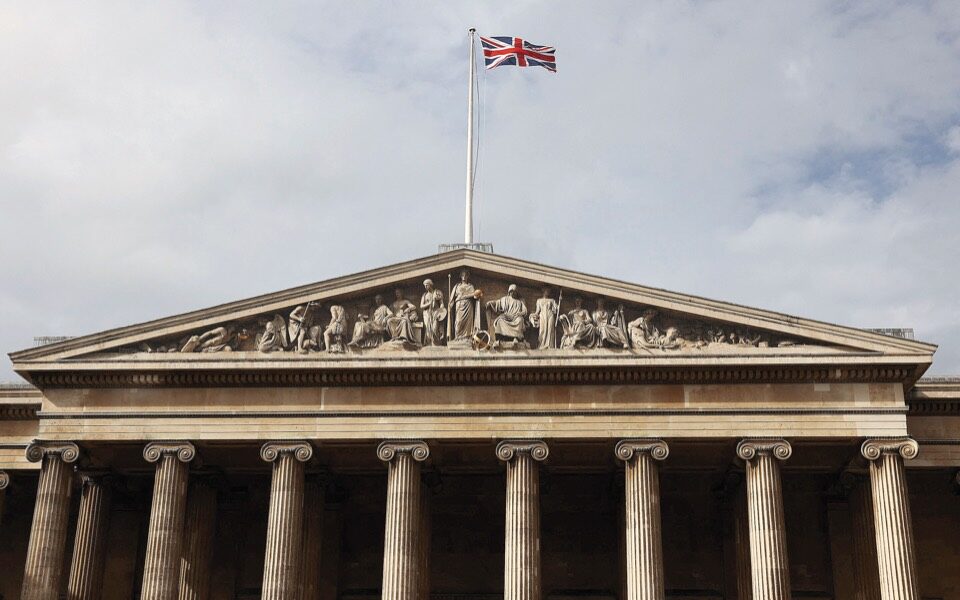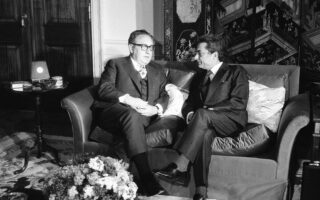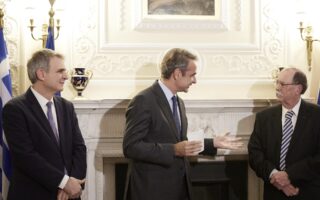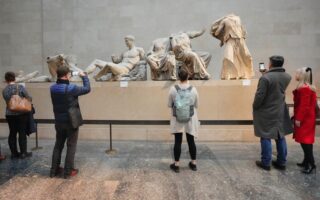A pathway to the reunification of the Parthenon Sculptures

Angelos Chaniotis, professor of ancient history and classics at the Institute for Advanced Study in Princeton, New Jersey, delivered a very topical lecture at the nonprofit educational institution College Year in Athens (CYA) titled “Divided Monument, Dividing Monument: The Controversy over the Parthenon Sculptures” on Wednesday. He was joined on the panel by Irini Stamatoudi, professor of law at the University of Nicosia, who has been actively involved in efforts to repatriate the Parthenon Marbles held by the British Museum.
 He began by providing a brief historical narrative of how the sculptures were removed from the Parthenon and early efforts to reunite them, mentioning an official request by the Kingdom of Greece in 1835 to this end. That was followed by isolated ventures until a concerted effort began with Melina Mercouri during her tenure as minister of culture in 1982, which was followed by the establishment of international committees, as well as the creation of a new museum.
He began by providing a brief historical narrative of how the sculptures were removed from the Parthenon and early efforts to reunite them, mentioning an official request by the Kingdom of Greece in 1835 to this end. That was followed by isolated ventures until a concerted effort began with Melina Mercouri during her tenure as minister of culture in 1982, which was followed by the establishment of international committees, as well as the creation of a new museum.
Finally, Chaniotis mentioned that the current government of Kyriakos Mitsotakis has given the issue a very prominent place on its agenda.
Chaniotis first addressed the issue by examining questions of legal ownership. The original document authorizing Lord Elgin, then British ambassador to the Ottoman Empire, to remove the sculptures between 1801 and 1812 has never been seen, and research conducted in the Ottoman archives has uncovered no trace of the sultan’s decree except for an Italian translation. “It was more than looting. It was the violent removal of the sculptures from the building,” he pointed out, noting that there was widespread destruction of other sculptures during the process of Elgin’s removals. “Elgin’s undeniable crime is not the theft, but the destruction of the integrity of a work of art.”
Chaniotis, however, highlighted the risk of a strict legal pursuit, warning that a court ruling in favor of Greece is uncertain as any court decision will be made on a legal basis of the extant rules at the time rather than modern cultural and moral standards. At the time, Greece did not exist nor did an international framework of law. “The legal aspect is secondary, even irrelevant,” he said, giving the example that at the time slavery was legal and homosexuality was illegal. “We cannot take decisions about a prominently cultural issue based on the legal framework that existed 200 years ago,” he emphasized, pointing out that “legal standards change.”
‘The Greek strategy does not work, and it is clear we are far away from a solution’
He also stressed that this case that should neither be judged on the basis of precedents nor should create precedents, as the Parthenon Sculptures present a unique case of the dismemberment and displacement of a monument. The reunification of the sculptures, he added, is the only morally and culturally acceptable solution.
In his opinion, the British Museum’s arguments in defense of its possessions have no moral basis. He proceeded to refute proffered claims of counterfactual history (i.e. what could have happened if the marbles hadn’t been taken by Elgin during the War of Independence) and the argument that there is no place adequate to display them in Greece with the construction of the Acropolis Museum.
The only defense Chaniotis gives credence to is the value of encyclopaedic, or universal, museums, which he described as the children of the enlightenment and colonialism. However, he points out that the Parthenon Sculptures, similar to the Benin Bronzes, are an exception to the overall argument. “The Parthenon Sculptures and Benin Bronzes did not become famous after their discovery and exhibition,” he noted, adding that they have been visible and admired throughout history.
He added that the sculptures in the British Museum are architectural structures and not freestanding statues, differentiating them from the Venus de Milo (Nike of Samothrace), and highlighting the difference between a collection of disparate items and a single work of art. “They are one single work of art whose fragments are scattered,” he emphasized.
He also addressed the possible motives of the British Museum and British governments in refusing to reunite the sculptures, highlighting that there is fear such a move would set a precedent for the return of all its collections; something he notes that until recently the Greek side has been entirely indifferent toward and which constitutes an existential threat to the museum.
Chaniotis then examined the strategy followed by consecutive Greek governments and concluded that it has been ineffective, and often contradictory. The Greek ministry refuses to recognize ownership, while the British Museum states that recognition of ownership is a precondition to any start of negotiations.
“The involvement of Prime Minister Mitsotakis has made things more complicated due to some contradictory statements,” he said, noting that the prime minister repeats the rhetoric that the sculptures have been stolen while signaling that he is open to a loan. “A loan unavoidably involves recognition of ownership,” states Chaniotis. He also points to the fact that the percentage of British people supporting the reunification of the marbles has dropped, stating that “the Greek strategy does not work, and it is clear we are far away from a solution.”
“One needs to redefine the dispute between a state and a museum or between two governmentsas a matter of cooperation between two museums,” he noted when looking to a possible answer to the current impasse.
In his opinion, as the Culture Ministry has not been successful so far in providing a roadmap to a solution, the matter should be assigned to a committee of experts and that, to avoid politicking, this should be appointed with an increased majority by the Hellenic Parliament.
Another avenue offered by Chaniotis is persuading several other museums that hold fragments of the Parthenon to return them to Athens, following the examples of the museums in Heidelberg, Palermo and the Vatican. If the British Museum is isolated, he noted, it will increase pressure on the institution.
The only moral solution is a donation, noted the professor, stating that there must “first [be] unconditional donation, then cooperation.” The act of donation, he added, the unconditional and permanent transfer would save the British Museum from any questions on the legality of possession of the marbles. It would also not be a quid pro quo transaction. “Cooperation after the donation is not a transaction, but a long-term strategy for culture,” he emphasized.
Finally, Professor Chaniotis concluded with an emotional appeal. “The British attitude is determined by fear,” a fear that a reunification of the Parthenon Marbles will set a precedent as well as an emotional fear of losing a relic of the British Empire. At the same time, the Greek attitude is dominated by indignation at a perceived injustice that has yet to be righted. To overcome these negative emotions, a positive one is needed, he noted. Hope. Hope for future cooperation, including displays from regional Greek museums that will provide the British Museum with periodic exhibitions.





